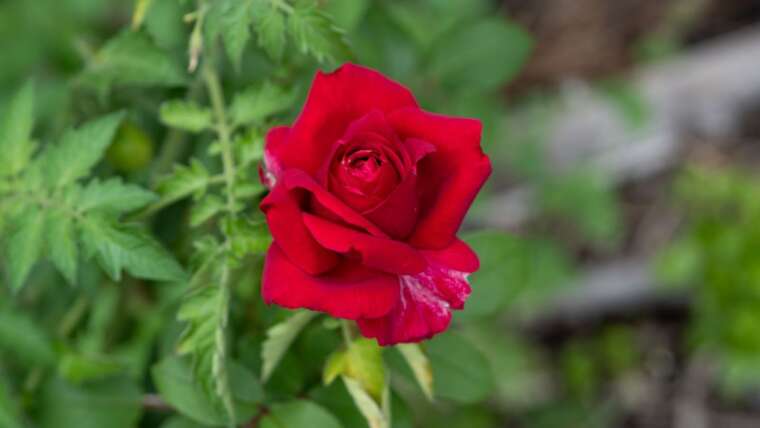In some mild climates, it is possible to garden outdoors, without protection, year-round. In these areas, it never or rarely snows. But for those of us who live in a less temperate climate, there has likely already been snow on the ground, or there will be soon.
If you’re like me, then you might have a hard time letting go of the garden this time of year. While some season extension techniques like frost cloth and greenhouse plastic can keep cold-hardy greens growing for a bit longer, there still comes a time when even the hardiest annual plants succumb to the snow and cold.
Although I admire the beauty of a blanket of white, I still miss the green garden at the height of summer. But it’s not all bad. There are some amazing benefits of a snowy garden, after all! Some perennial plants like blueberry bushes, lilacs, and peach trees require some chill hours to bloom the following spring. Chill hours refer to the time a plant needs to spend below 45 degrees Fahrenheit (7 degrees Celsius).
Learning about these benefits of the cold and snowy winter has given me an appreciation for this season of slowdown and hibernation.
Snow Acts as an Insulator
Fresh snow is good insulation, protecting perennials from cold and retaining warmth around roots.
Snow is 90-95% air, which makes it an excellent insulator. There is a reason why the Inuit built igloos from ice and densely packed snow to stay warm in frigid temps. Due to the insulation properties of snow, Igloos can retain body heat to stay warmer than the outside air temperatures.
Similarly, a freshly fallen blanket of snow can protect perennials from an approaching cold snap. For overwintering perennials, keeping an eye on the upcoming weather is especially important. A sudden cold snap before perennials enter dormancy can severely damage and kill your plants.
If the cold snap, however, is preceded by a snowfall, then have no fear! The blanket of snow will retain warmth around the root zone of the plants and protect them from severe cold.
Snow Prevents Temperature Fluctuations
 It moderates, preventing temperature swings and protecting plants from premature growth.
It moderates, preventing temperature swings and protecting plants from premature growth.
A blanket of snow that sticks around the garden also acts as a climate moderator by preventing temperature fluctuations. Particularly during the early and late winter, there can be swings in temperature from mild to freezing, sometimes overnight. A layer of snow can shield against this freeze-thaw cycle and prevent these temperature fluctuations from confusing or damaging your plants.
Without the presence of snow, the warm sun could trick perennials and bulbs into sprouting. You’ll see this sometimes with fall-planted garlic bulbs. During a year with a mild start to the winter, they may sprout and poke through the soil.
In late winter, as the longer days begin to warm the soil, daffodils are notorious for popping up before the threat of frost has passed. A layer of snow indicates to these plants that it’s not yet time to resume growth.
Snow Delivers Nitrogen
 Piles of snow act as a natural nitrogen fertilizer, enhancing soil for vibrant spring plant growth.
Piles of snow act as a natural nitrogen fertilizer, enhancing soil for vibrant spring plant growth.
Another amazing benefit of snow is that it delivers nitrogen to your soil. For this reason, it is sometimes called “poor man’s fertilizer.” Both rain and snow deliver nitrogen to your plants. This is why the garden looks so green, lush, and vibrant after rainfall.
As snowflakes fall through the atmosphere, they pick up nitrogen. The snow then delivers this nitrogen into the soil as it melts. This can be a much-needed boost for plants in spring, especially after winter dormancy.
Snow Delivers Water
 Water overwintering perennials as needed, especially for new plants, unless snow is forecasted.
Water overwintering perennials as needed, especially for new plants, unless snow is forecasted.
Although the heat of the summer is long gone, that doesn’t necessarily mean that you’re done watering the garden, specifically your overwintering perennials. This is especially important for newly planted perennials during their first winter.
A good rule of thumb for perennials you are trying to establish over winter is to water them as needed, provided that air temperatures are above 40 degrees Fahrenheit (4 degrees Celsius) and the ground is not frozen. Check the soil moisture in the top few inches of soil to determine if these plants need a drink.
The caveat to the above-mentioned rule of thumb is that you don’t need to water your perennials if, you guessed it, there is snow in the forecast! Snow will provide much-needed moisture to these plants over the winter and limit the need to hand water, which is great for gardeners that prefer a break from garden maintenance during winter.
Snow is Nature’s Mulch
 Mulching benefits include erosion protection, organic matter addition, and moisture retention, aided by winter snow.
Mulching benefits include erosion protection, organic matter addition, and moisture retention, aided by winter snow.
There are many reasons for the many types of mulch, including protecting the soil from erosion, adding organic matter to the soil, and retaining moisture. Snow can provide a few of these benefits as well!
During the winter, the snow protects the soil from sun exposure and wind erosion. Those of us who live in areas where snowfall tends to stick around for long periods get the full benefits of snow as mulch. A consistent layer of snow on the soil can also help the soil retain its existing moisture.
Snow is a Seed Starter
 It provides natural cold stratification, essential for spring sprouting of seeds.
It provides natural cold stratification, essential for spring sprouting of seeds.
The cold, wet conditions that snow provides are exactly what is needed for certain seeds to sprout in spring. Cold stratification occurs naturally when seeds are sown outdoors in late fall or early winter. You’ll see this occur naturally when many plants dry up and go to seed in autumn.
Their seeds fall to the ground and germinate the following spring. Without this period of cold stratification, some seeds may remain dormant and never germinate. The warming weather of spring after the cold and wet winter indicates that it’s time to sprout.
A few examples of seeds that require cold stratification include milkweed, black-eyed susan, larkspur, and coneflower. In areas that don’t receive snow, you might need to simulate this cold stratification period by placing seeds in the refrigerator. Without this period of simulated dormancy, it is possible to germinate some seeds, but the germination rate may be much lower. But those of us who receive regular snowfall in winter have the cold stratification task taken care of by Mother Nature.
Snow Reveals Visitors to Your Garden
 Animal tracks are more visible after snow, providing insight into your garden’s unseen visitors.
Animal tracks are more visible after snow, providing insight into your garden’s unseen visitors.
An often overlooked benefit of freshly fallen snow: it can reveal a variety of tracks and might give you insight into otherwise unseen visitors or residents of your garden. If you aim to create a wildlife-friendly garden, seeing the tracks is a fun reward for your labor.
Other times, you might want to be aware of unwelcome guests and their predators. I live in a suburban area surrounded by farms in which there are many working cats. At a certain point this year, I saw some mice scurrying through my garden. Shortly after, the cats showed up.
Aside from their tracks in the snow giving them away, I wouldn’t have known the cats were there. They appear to be mostly hunting at night. The snow also gave away the locations of the mice and where they were sheltering.
Living in a rural area or not, you might be surprised by what tracks show up in your gardens. Birds, rabbits, mice, cats, foxes, skunks, coyotes, and more, depending on where you live. Most wild animals avoid humans, and you’d never know they were there aside from the tracks they leave behind.
Final Thoughts
While there are many benefits to a layer of snow covering the garden, it is important to mention that heavy, wet snow can damage young trees and shrubs. If you see a plant bending under the weight of the snow, gently brush it aside. Do not be tempted to remove icicles that have formed on plants, as this can cause bark to pull away or tender twigs to snap. Just leave it in place to melt on its own.
All in all, a snowy garden has more benefits than downsides. If your plants suffer winter damage, it’s more likely to be caused by extremely low air temperatures rather than the snow itself. Perennial plants have survived over winter for millions of years without human intervention.




